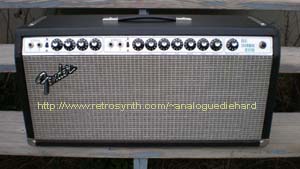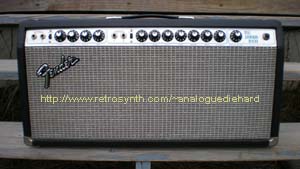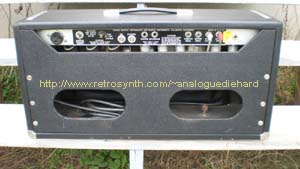Fender 1976 Dual Showman Reverb Guitar Amplifier
Last Update 04-15-2012
Guitar amplifiers are evil. Just when
I thought my Selmer
Twin
Thirty and Vox Valvetronix were enough for the studio, I discover
they are not. My styles had been expanding, and I felt that my
Fender
Rhodes could benefit from a proper guitar amp (back in the 1970s
before proper keyboard amps existed, keyboard players had to play
through guitar amps). The silverface Fender Twin Reverb was a
very popular amplifier for guitar players,
and it was the amplifier of choice for Rhodes piano players. So I
sought yet another vintage amplifier,
and also possible $$$ for the restoration efforts that go along with it.
During the rapid expansion of the CBS/silverface era, many
inexperienced assemblers were put to work assembling tube guitar
amplifiers. Many a guitar repair shop found that the majority of
silverface Fender amps - estimated at 80% - were wired incorrectly when
they left the factory. Final inspection at the factory only
verified that the amp
made sound at all - quality control was nonexistent. I would
agree
with this as I did audition a 1969 silverface Twin Reverb at another
store, and it had horrible icepick treble sound, not at all tubey or
fenderish. I knew that buying one without auditioning it in
person was
extremely risky so the 'net auctions and classifieds were not an
option.
But
the silverface Twin Reverbs, once a bargain on the vintage market,
were starting to climb in value. They were also a pretty heavy
package for a combo. Since I am an advocate of separate heads and
cabinets (I like to swap cabinets with different speakers to experiment
with sound varieties) I wondered if Fender ever made a head version of
the Twin
Reverb. Turns out they did - they used the same chassis, same
circuit, tubes, transformers - everything - in five different
silverface
amplifier models - Twin Reverb, Vibrosonic Reverb, Quad Reverb, Super
Six Reverb, and Dual Showman Reverb. They all simply used
different speaker configurations for different sound, with the
exception of the latter which was a non-combo head. The DSR were
sold head only or with a large 2x15 cabinet (an optional additional
2x15 cabinet was available for spoiled rich brats). If you
thought the 2x12 Twin Reverb was heavy, try the goliath Super Six
Reverb with six 10s!
The idea of sharing the same chassis across different models was not
new at Fender as several amps from the 1950s also shared that
convention.
Also CBS used some really crappy sounding speakers in the silverface
amps (with the exception of the JBL D1x0F), which can be replaced with
better sounding speakers if you have
the $$$. But by springing for a head version that was not a
concern as
I already had a variety of cabinets with different speakers.
A search uncovered FOUR circuit revisions throughout the silverface era
(1968 to 1982) but a study of the schematics did indeed confirm that
all five models shared the exact same chassis and circuits. The
early ones are the most desireable as they were the same circuit as the
blackface Twin Reverbs. Then assembly of tube guitar amps got
extremely lax - inexperienced assemblers got sloppy with lead dress
which resulted in uncontrollable oscillations. In a classic case
of fixing the symptom instead of curing the disease, CBS added
components at the power tubes that suppressed the oscillations, taking
any form of that "Fender sound" with it. This was the blackest
era of CBS/Fender amp history, as retailers complained loudly of these
bad sounding amps. The changes only lasted for six months and it
took so long for the retailers to sell off the jaded amps that it
dawned the vintage era - players quickly learned that the older
"blackface" amps sounded much better and they rose in value. The
CBS silverface was forever tainted and Fender was getting a bad
reputation. The circuit was revised in 1972 to introduce the
master volume, then some time later the master volume acquired a pull
switch that engaged a distortion sound. Around 1974 the "hum
balance" trimpot was designed so that Fender could install twin
unmatched 6L6 power tubes and save $$$ on hand matching. But the
"hum balance" did not do its intended purpose. The last version
(and least desireable) silverface Twin Reverb boosted the power from
100 watts (four 6L6 power tubes) to 135 watts (six 6L6 power tubes!)
and added a preamp output for recording. So the ideal amp was the
first ones of the silverface era, without master volume without hum
balance trimpot and without the dreaded CBS "fix".
So the hunt was on for the ideal amp. I was slowing down my gear
purchases in the interest of building a house so I wasn't actively
scanning the 'net auctions or classifieds for them. One day I was
out of town to my favorite electronic supply place and remembered that
there was a new vintage music store across the river. The store
had closed for the day but a peek in the window arose suspicion that
there was a DSR in there. Then a week later I stopped in and it
was indeed a DSR. It was a master volume head with the dreaded
"hum balance" trimpot (I preferred the earlier models which preceded
these features) but this specimen are extremely clean like new.
When I auditioned it there was zero hum, zero buzz, no audio artifacts
at all. Just that beautiful Fender clean tone, and the spring
reverb was heavenly. The only problems were a couple of scratchy
pots on the panel. But the price was very reasonable. So I
not only landed a clean unit but was lucky enough to
land one of the 20% that were wired correctly at all.
These master volume amps with pull switch distortion are not the most
desireable Fender amps. The master volume robs tone from the
power tubes and in the 1970s CBS/Fender was so disconnected from the
current tastes that they added a distortion switch (pull out the master
volume knob) which
doesn't sound at all like overdriving preamp tubes. The effect is
subtle - it sounds like a slight midrange boost with mild
breakup. Rather useless. The Twin Reverb circuit doesn't
really
start to overdrive until it is almost wide open near 100 watts and at
rather unbearable volume. They were known to sound good with
distortion pedals and the like, but better at clean sounds. Thus
they were widely neglected when the heavy metal era arose in the early
1980s followed by the grunge and modern rock of the 1990s and 2000.
Like the opportunist I am, that was fine with me as I cared little for
those genres. But styles do have a way of revolving, and Twin
Reverbs were back in demand starting in the mid-2000s. Twin
Reverbs were climbing in value, while I noticed the other models with
the same chassis were much lower in value. So by purchasing this
Dual Showman Reverb I got the sound of the Twin Reverb at the fraction
of the price. While I could hear a difference with the master
volume at low settings, if left at maximum it is nearly identical to
the non-master volume amps and does sound better. And that "hum
balance" trimpot? I hear no artifacts that degrade the
sound. I'm an advocate of the "if it ain't broke then don't fix
it" credo. I don't see a need to address it until the power tubes
are ready to be replaced, at which point I will have an expert amp tech
convert it to a proper bias trimpot.
I was able to date this amp by two traits: the serial number on the
back (there is info online with serial number correlated with year of
manufacture) and the post-1975 logo on the front which was missing the
"tail" underneath.
The Dual Showman Reverb use an RCA 7025 tube on the preamp front end (a
12AX7
graded for lower noise and highly sought after) with a 12AT7 phase
inverter pushing a quartet
of 6L6 power tubes. It is a non-stereo dual channel (non
switchable) system with both channels featuring
volume/treble/middle/bass controls and one channel featuring reverb and
tremolo (mistakedly labeled "vibrato" on the panel). The
amplifier can generate 100 watts and is very loud and clean, but
pleasantly colored for that then-famous Fender "clean sound". In
another example of how CBS was so out of touch with the current tastes,
they still strived to produce an amp that delivered squeaky clean sound
while the Marshalls and Mesa Boogies were pointing the way of the
future. But one thing was in CBS's favor - they stocked the amps
with decent tubes made by RCA, which isn't true with today's Fenders
leaving the factory with cheap inferior sounding chinese tubes.
Luckily my DSR had seen so little use that it still had the original
RCA tubes in it.
I tested four cabinets with the DSR, each with my strat, tele, and les
paul to experiment with tone variety. My 2x15 Bassman closed
back cabinet for the DSR - with the original Oxford and an unknown
speaker - sound deep and full especially with the reverb. My
Peavey 2x15 bass cabinet loaded with EVs was an absolute dud, played
four chords and I unplugged it fast. Proof that not all 2x15
cabinets sound good with guitar. The Marshall 4x12 loaded with
two Celestion 65 watt and two 70 watt speakers sound good all
around. My Vox 2x12 closed back cabinet loaded with Celestion
alnico 12 watt "Blue" speakers sounded great, crisper than the
Marshall. In an attempt to restore authenticity I ordered a pair
of Jensen 50w 15" speakers - while they sounded good with Rhodes piano
I preferred the original speakers for guitar. I don't identify a
favorite - they all have their
distinctive sound.
Moving onto the Rhodes - the Bassman cabinet loaded with 2x15 Jensens
and Vox cabinet
sounded the best. While the DSR definitely gets that "classic"
Rhodes sound, I still prefer the sound of the Selmer on the
Rhodes. I had hoped that the DSR would serve as a high power
system for the Rhodes, but like the Selmer it does start breaking up
past a certain threshold (it wasn't the speakers breaking up, it was
the amp). The Selmer had better tone color, and the presence of
the tube rectifier gave the Rhodes a punch that the DSR did not
have. In the future I plan to build a new speaker panel for the
bottom cabinet of the Rhodes to accomodate the Jensen 15s, since that
cabinet is already empty. A simple speaker jack panel and it will
be ready to go.
Another interesting experiment for later is to try my speaker emulators
- the Red Box and the Groove Tubes.
The DSR is an excellent bargain for anybody looking for that Twin
Reverb sound - all you need is a cabinet with decent speakers.
The amp chassis is designed for 4 ohm loads, but 8 or 16 ohm loads can
safely be used with it (albiet at decreased volume). As with any
vintage amp, be prepared to spend more $$$ on a check-up by an expert
amp tech as you may find leaking capacitors (long past their expected
life), worn tubes, loose tube socket connectors, bad output
transformers. This can get expensive in a hurry.

Home








